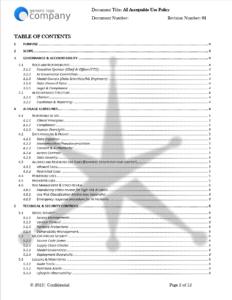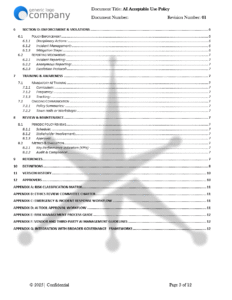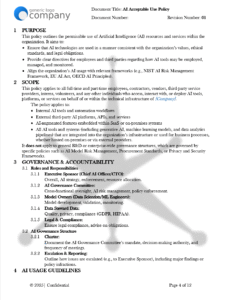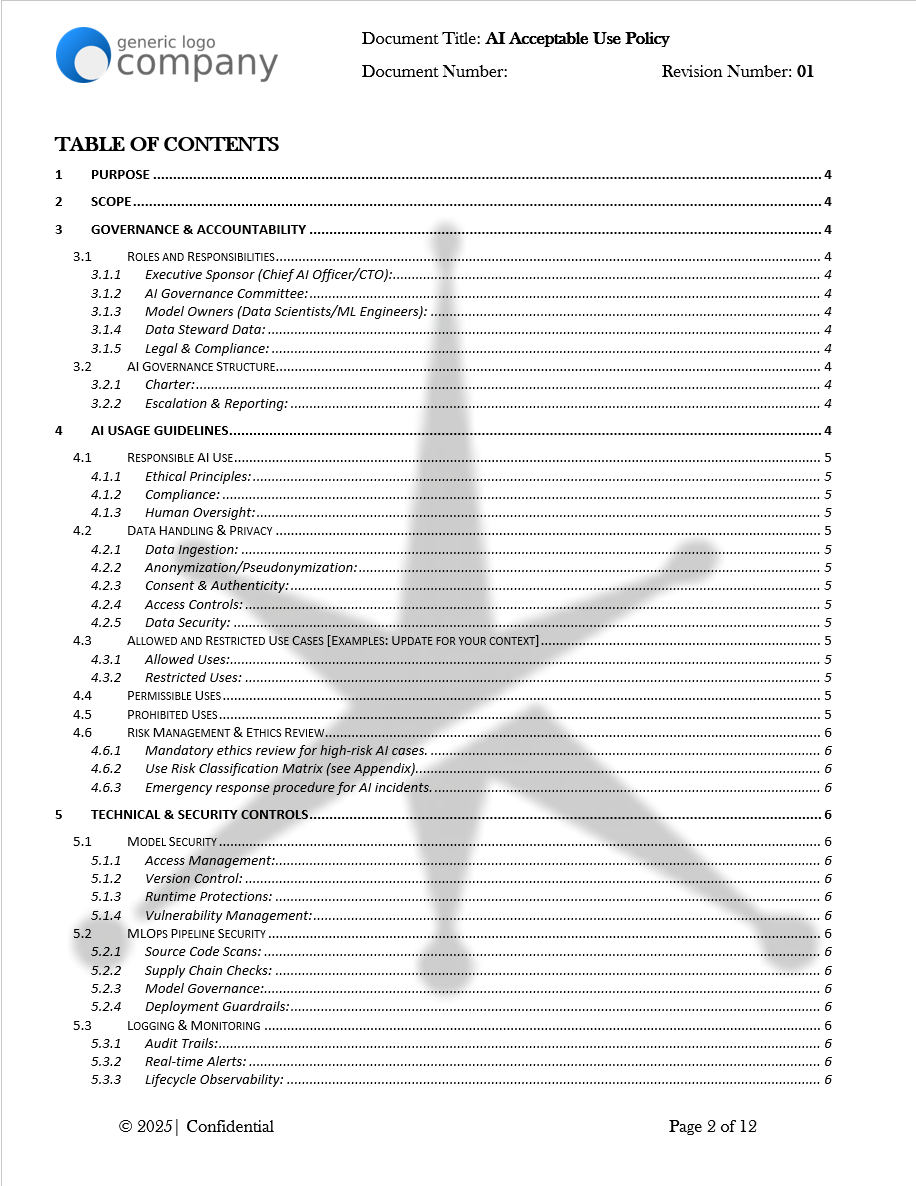
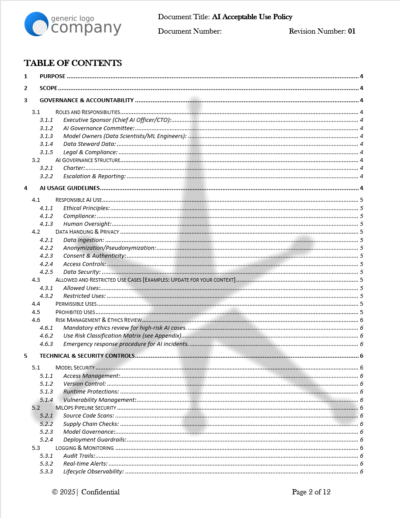
- Version
- Download 0
- File Size 17.30 KB
- File Count 0
- Create Date August 19, 2025
- Last Updated August 23, 2025
AI Acceptable Use Policy Template — Professional Edition
Define ethical boundaries, safeguard data privacy, and ensure responsible AI adoption aligned with global standards.
Get Started with Acceptable AI : [Download Now]
This AI Acceptable Use Policy Template provides organizations with a compliance-grade framework to control how AI systems are deployed and governed. It establishes clear guidelines on permissible and prohibited AI practices, integrates technical controls, and ensures alignment with regulatory expectations.
Key Benefits:
-
✅ Regulatory Alignment: Designed around EU AI Act, NIST AI RMF, ISO/IEC 42001, and GDPR.
-
✅ Clear Boundaries: Defines allowed vs. prohibited AI uses for ethical deployment.
-
✅ Privacy by Design: Includes data minimization, anonymization, and secure handling.
-
✅ Technical Safeguards: Access management, MLOps security, and monitoring controls.
-
✅ Audit-Ready: Enforcement, reporting, and escalation procedures included.
Who Uses This?
Compliance officers, CAIOs, legal teams, and AI governance committees ensuring responsible adoption of AI technologies under global compliance standards.
Why This Matters
As AI adoption expands, regulators and stakeholders expect organizations to define responsible boundaries for usage. Without an AI-specific Acceptable Use Policy, businesses risk ethical lapses, regulatory violations, and reputational harm. This template provides a ready-to-customize governance tool that embeds compliance, accountability, and risk mitigation into your AI strategy.
Framework Alignment
This template supports compliance with:
-
EU AI Act – Defines prohibited AI practices and governance oversight.
-
NIST AI RMF – Integrates risk classification and ethics review processes.
-
ISO/IEC 42001 (AI Management System) – Builds AI governance into enterprise management.
-
ISO/IEC 27001 – Strengthens security controls and access management.
-
OECD AI Principles – Reinforces fairness, transparency, and accountability.
-
GDPR & HIPAA – Protects privacy, consent, and secure data handling.
Key Features
-
Governance & Accountability: Roles for executives, AI owners, compliance, and legal.
-
Responsible AI Guidelines: Ethical principles, compliance obligations, and human oversight.
-
Data Handling & Privacy: Consent, anonymization, access controls, and security.
-
Allowed vs. Prohibited Use Cases: Clearly outlines acceptable vs. restricted practices.
-
Risk & Ethics Review: Risk classification matrix, mandatory reviews, and emergency procedures.
-
Technical & Security Controls: MLOps pipeline security, vulnerability management, logging, and alerts.
-
Enforcement & Violations: Disciplinary actions, mitigation steps, and anonymous reporting channels.
-
Training & Awareness: Role-specific AI training programs, town halls, and policy summaries.
-
Integration with Governance: Links to charters, incident response plans, and vendor oversight.
Comparison Table
| Feature | Generic Use Policy | AI Acceptable Use Policy (Professional) |
|---|---|---|
| Mentions ethical AI | General statement | Responsible AI principles tied to EU AI Act & OECD |
| Allowed vs. prohibited use | Often missing | Explicit allowed, restricted, and prohibited cases |
| Data handling | Basic | GDPR/HIPAA aligned privacy & consent controls |
| Technical safeguards | Not included | MLOps pipeline security, runtime protections |
| Enforcement | Vague | Clear disciplinary & escalation procedures |
| Integration with governance | Not referenced | Works with AI Governance Charter + Incident Playbook |
FAQ Section (Schema-Friendly)
Q1: What regulations does this policy align with?
A: It references EU AI Act, NIST AI RMF, ISO/IEC 42001, GDPR, HIPAA, and OECD AI Principles.
Q2: Who should adopt this policy?
A: Suitable for SMEs and enterprises deploying AI in high-risk or regulated environments.
Q3: How does it support privacy compliance?
A: It includes data anonymization, pseudonymization, access controls, and consent mechanisms.
Q4: What’s unique compared to a generic AUP?
A: It is AI-specific, with governance integration, technical safeguards, and compliance-grade enforcement.
Q5: Does it integrate with other governance tools?
A: Yes. It complements the AI Governance Charter, AI Risk Management Framework, and Incident Response Playbook.
Q6: How often should it be updated?
A: At least annually or whenever new AI regulations, risks, or organizational changes arise.


